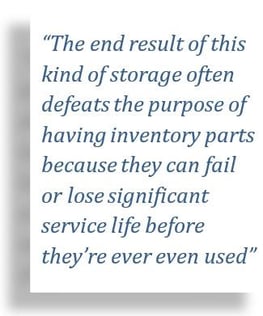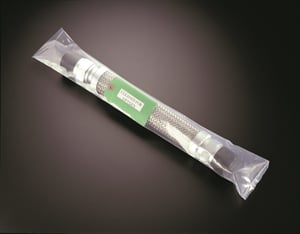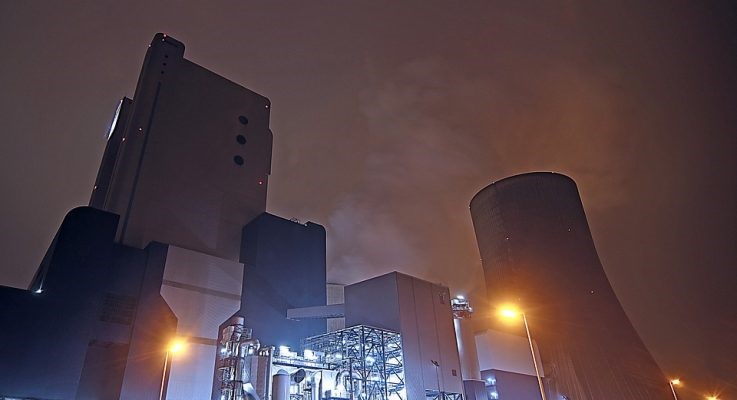Maximizing Service Life: Recommendations for Hose Inventory and Storage
When it comes to industrial products and applications, much of the discussion is focused on how to pair the right product and the right application. There are so many different manufacturers of components that offer different features and benefits to suit the huge variety of factors that can affect plant components regardless of the industry. Vibration, corrosion, media consideration, service life, flow velocities, fluid dynamics…there are too many to list here! But what often gets ignored is how to handle and store those products before they ever get put into service.
After personnel safety, avoiding unplanned downtime is the main priority for all industrial operations. Plants typically keep an inventory of maintenance items like hoses on hand to swap out as needed to minimize lost production time. Unfortunately, this inventory is not always stored or cared for properly. I personally have visited power plants where they kept replacement hoses, pumps, gaskets, and flanges on the ground outside. The end result of this kind of storage often defeats the purpose of having inventory parts because they can fail or lose significant service life before they’re ever even used. While these storage concepts apply to all maintenance components, let’s discuss metal hoses specifically.
External Considerations
The storing of hoses outside may come as a bit of a surprise (or may not) but it’s actually relatively common. Rain or dust seem like insignificant elements to stainless steel but they can actually facilitate a great deal of damage, especially over time. With rain, the phrase “evaporation equals concentration” helps to illustrate this point. Everything that is picked up by the rainwater on its way down (including nearby plant gasses) is delivered in a diluted state, but as the water slowly dries up, it leaves behind a concentrated residue that can cause corrosion (especially if the hose is in a position to collect water that can then pool on the interior).
Dust and particulate matter can do this too, especially inside the plant. Maintenance storage cribs and spare parts inventories can often be found near the equipment they’re meant to service. Heavy dust and particulate matter from process equipment can pick up other chemicals and off gases that are present in the plant, and carry them down onto the outside of uncovered hoses. This new mixture can cause unintentional chemical reactions that can corrode the exterior of the hose. I know of a specific instance in a coal-fired power plant where a baghouse collecting ash was improperly releasing a large amount of particulate…which then combined with lime dust and landed on nearby hose assemblies causing the exterior to become embrittled and fail. Even in cases where corrosion isn’t an issue, these fines can buildup on the outside of the hose in-between the corrugations and underneath the braid. This can be difficult or impossible to clean out, and can affect the hose corrugation’s ability to flex, or can become entrapped in the braid causing increased wear.
Hose Options for Storage
 Fortunately, there are simple remedies for most of these issues. It’s always up to the end-user how they want to properly address their plant processes: be it either with a modification of the hose itself, or by rearranging how they store the hoses in the plant. Let’s break down each one separately:
Fortunately, there are simple remedies for most of these issues. It’s always up to the end-user how they want to properly address their plant processes: be it either with a modification of the hose itself, or by rearranging how they store the hoses in the plant. Let’s break down each one separately:
Plant Options
Making adjustments to plant layout and established operations can be a challenge, but is probably the best overall option when it comes to longevity. For storage, it’s always best to keep the components out of the open air, and away from the elements. Using wooden crates, plastic containers, or even cardboard boxes (though in some environments cardboard can actually make it worse by getting wet and then storing moisture along with the hoses) can often greatly improve the overall cleanliness of the assemblies for when they’re ready to be used. Keeping the preferred containers off the ground will also prevent them from getting wet.
Hanging racks are a common way to organize various items including hoses, but make sure the hoses are still contained. Some racks store unpackaged hoses by draping the assembly over two points that allow the hose to hang in an upside-down “U”. This is the better way to store them if they are to be uncovered, as water and particulate will have a much harder time getting into and staying inside the hose. Avoid hanging the hoses from one end fitting in a vertical fashion (or even worse, in an upright “U”) because this allows much more contaminant into the assembly over time.
Finally, be mindful of the flexibility of the hose. Metal hoses have bend radius limits on how far they can be bent before they become “plastically deformed” meaning that they won’t spring back. Think like a paper clip: it can be bent a certain degree, but if you bend it extremely, it will stay and not spring back to its original shape. All manufacturers publish bend radius information in their catalogs, so be sure not to over bend the hose when putting it into storage, or else it will already lose valuable service life before it ever gets into the application!
Hose Options
 Changing how you order your hose assemblies to better protect them during storage can cost a few dollars up front, but is probably the simplest and easiest solution. There are quite a few inexpensive options available to ensure the quality of your assemblies lasts until they’re ready to be used and give you peace of mind in the meantime.
Changing how you order your hose assemblies to better protect them during storage can cost a few dollars up front, but is probably the simplest and easiest solution. There are quite a few inexpensive options available to ensure the quality of your assemblies lasts until they’re ready to be used and give you peace of mind in the meantime.
The main objective is again, to keep outside contaminants off of and out of the hose. Bagging the hose in a sealed plastic bag ensures that the hose will be just as clean on its first day of service as it was when it left the factory! Ordering the hoses with caps on the ends and/or having them temporarily sealed with plastic is another added layer of protection, and can be helpful even if the hoses aren’t externally bagged (this will also protect the threads or sealing face of the fitting and ensure a leak-free connection).
Lastly, traceability and identification can make managing spare parts much easier. There are a variety of simple identification options ranging from tags to permanently etched fittings that make short work of identifying a particular hose, its material, when it was purchased, and how long it’s been in service. This makes it easier to judge the quality of your storage operation over time, and how well the hoses are lasting before and during service.
There are a lot of variables that go into making the best storage decision for a particular operation. If you need help selecting the best option for your facility, you can always call or email us at 216-481-2020 or insidesales@hosemaster.com to get assistance!
About Erik Kane
Erik Kane has been a proud member of the Hose Master team for the past 7 years. During that time, he’s helped develop primary research programs, training tools, promotional materials, assisted metal hose end users and distributors on-site, and worked in production on Hose Master’s manufacturing floor. When he’s not digesting hose information or blogging about the industry, Erik enjoys playing video games, watching Westworld with his dog Nibblet, and powerlifting.



